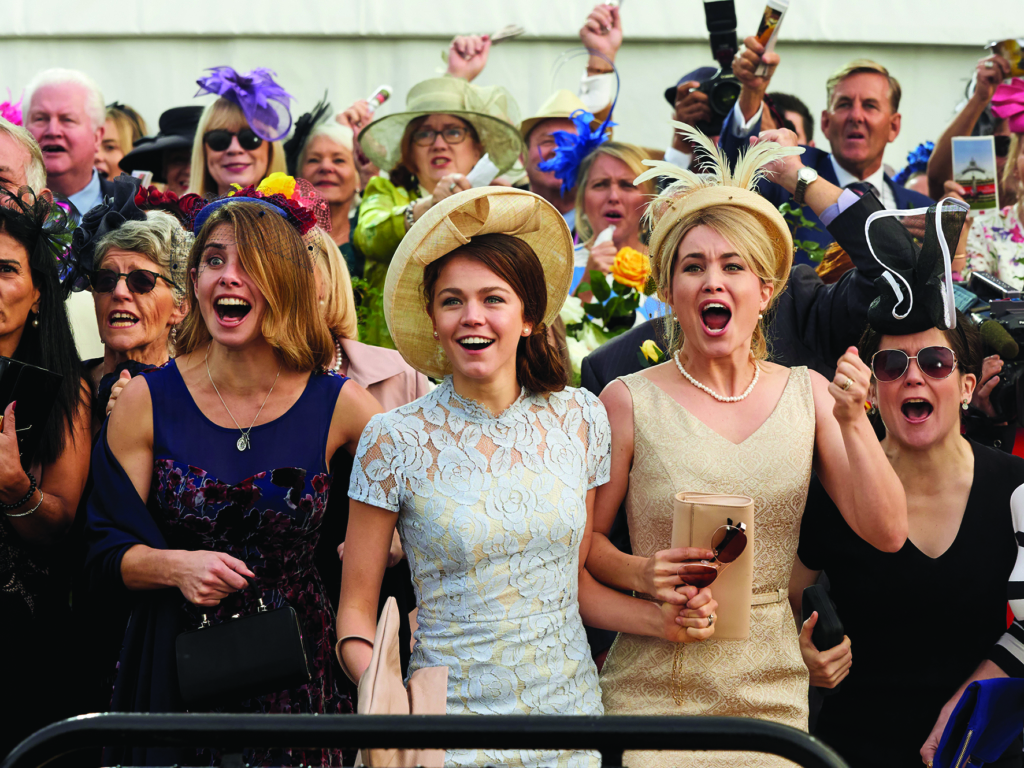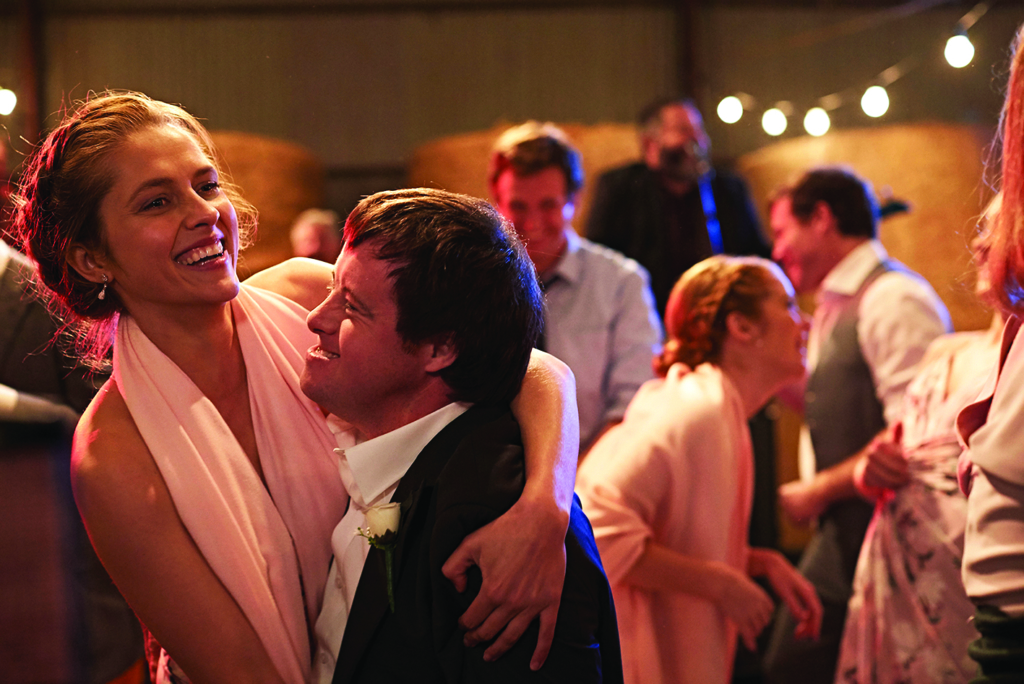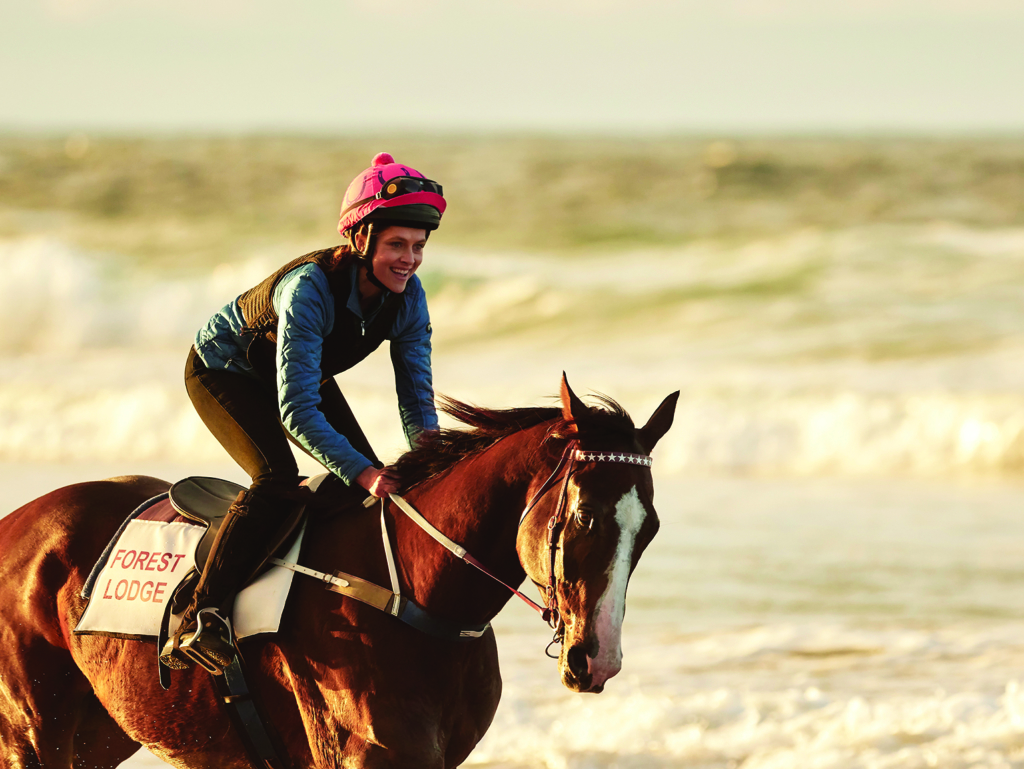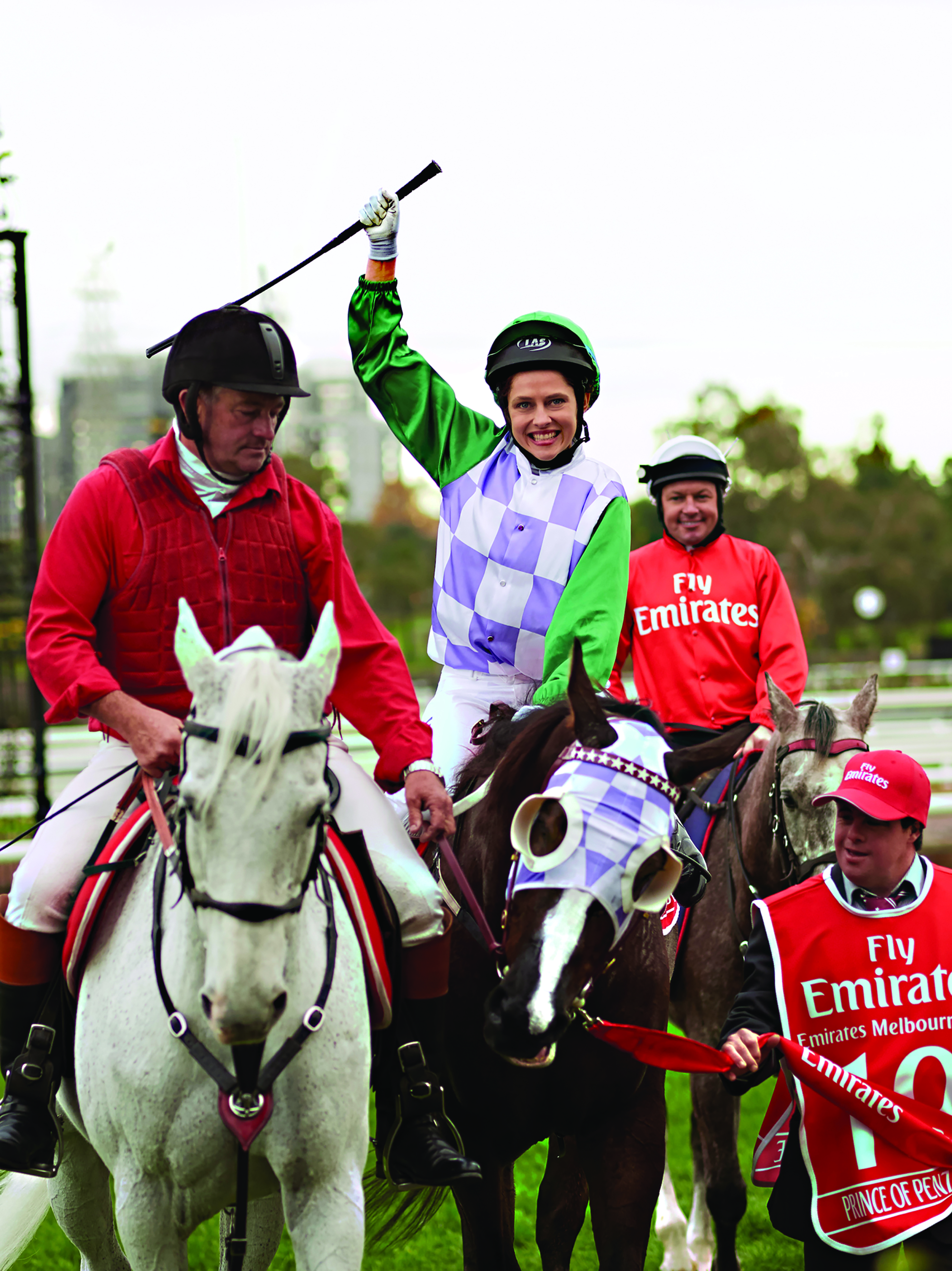A trademark of Australian stories is the celebration of the underdog. In Ride Like a Girl (Rachel Griffiths, 2019), Michelle Payne (Teresa Palmer) crosses the finishing line at the Melbourne Cup, and there’s a moment of ecstatic reckoning: this is the first time a female jockey has ever won the race in its 155-year history. It’s a scene that instantly captures the film’s drawcard as an unconventional Australian biopic, renouncing the abundance of male-dominated sports dramas that have preceded it. This time, a woman has proven she can do exactly what a man can in the sports arena – she’s tough and resilient, and, most impressively, she’s smashed a glass ceiling. But underneath the exhilaration of Payne’s joyous victory, Griffiths’ directorial feature debut obscures a crucial element whose absence holds back the reins of her film: a self-aware interrogation of the industry within which this feminist success operates, and the means by which it is achieved.
Ride Like a Girl opens with a title card establishing the Melbourne Cup as the world’s ‘toughest two-mile horse race’, and as a nationalist tradition that strikes at the heart of Australian identity: ‘For 150 years the Melbourne Cup has been the holy grail of horse racing, chased by royalty and business tycoons the world over […] Every jockey dreams of riding in the Cup.’ After documentary footage of the Cup has cut to childhood home videos, the final sequence of the opening montage shows the real-life Payne, at the age of six, staring right into the camera and confidently declaring: ‘I just wanna win the Melbourne Cup.’ In these preliminary moments, Griffiths correlates her protagonist’s warm, chaotic upbringing – as the youngest of ten, in her country home near Ballarat in Victoria – with the career dream that she eventually realises. The film romantically depicts this obsession as the main occupant in her and her siblings’ minds: bird’s-eye-view shots show their lush, green garden marked as a mini racetrack as they take turns wearing bridles, role-playing as horses and jockeys – and all with a running commentary of the race provided through a toy megaphone. In this picture-perfect Catholic household, headed by crinkly-eyed single father Paddy (Sam Neill), pet horses stick their noses through windows and food playfully flies across the table during Christmas lunches.

This infatuation with horseracing runs in the veins of the family, with Michelle following in the footsteps of her siblings – seven of whom become jockeys. At her country-town primary school, sitting on a chair with her legs spread like she’s on a horse, she cheers on her brother Patrick as he races at the 1991 Melbourne Cup. ‘It’s an upside-down race,’ Paddy explains to her as she climbs dejectedly into the back of the van following Patrick’s disappointing loss, but it’s the first spark she needs to begin setting her eyes on the end prize. It’s the same when she’s on the sidelines watching local races through her binoculars, her hopes dismissed as a pipedream, something only possible for boys: ‘Girls don’t ride the Melbourne Cup,’ her brother Stevie (played by himself in the film) says to her.
Flash forward ten years, and Michelle is sneaking away from her high school classes to listen in on radio broadcasts of her eldest sister, Brigid (Anneliese Apps), racing. ‘You don’t have to follow your sisters; make your own choice,’ her frustrated Catholic-school teacher (Magda Szubanski) lightly scolds when she finds Michelle in a toilet cubicle with a guilt-laden expression. But, as Griffiths builds up in these childhood sequences, for Michelle, there’s little personal choice. On the TV in her family home, Phar Lap (Simon Wincer, 1983) plays on repeat – with particular emphasis given to the iconic scenes of Harry Telford (Martin Vaughan) riding the thoroughbred up through the sandy dunes in dramatic slow motion. After all, there’s no figure quite as legendary as Phar Lap to represent the way the Melbourne Cup has been immortalised and etched into the fabric of Australian history. The horseracing event ‘that stops the nation’ has been the subject of several Australian films in addition to Phar Lap, including Thoroughbred (Ken G Hall, 1936) and, more recently, The Cup (Wincer, 2011) – all of which depict that it is, indeed, a thrill ride to witness an Aussie battler win against all the odds, as Michelle does in Ride Like a Girl. Scholars Carole M Cusack and Justine Digance suggest that horses and, subsequently, the Cup have had an important part in the forging of mythic Australian identity: the former linked initially to the white, male ANZAC legacy in the ‘courage and tenacity of the soldiers who fought in the First World War’;[1]Carole M Cusack & Justine Digance, ‘The Melbourne Cup: Australian Identity and Secular Pilgrimage’, Sport in Society, vol. 12, no. 7, 2009, p. 881. the latter becoming Australia’s premier event, celebrating the ‘Australianness’ associated with excessive drinking and gambling.[2]ibid., p. 885. Part of this, they argue, derives from the way that racing in Australia has become reinvented as a form of entertainment spectacle – packaged with an ‘atmosphere of expectation and the possibility of riches [… as well as] belief in magic and miracles’.[3]ibid., p. 883.

There’s a certain desire apparent in Ride Like a Girl to emulate the imagery created in Phar Lap, especially when a young Michelle gallops into the beautiful orange-hued sunset as her Dad looks on – or, later, when drone shots capture the crashing waves as she takes her future winning horse, Prince of Penzance, for their first ride together on the attractive expanse of an empty Australian beach. But despite the attempts to parallel Prince and Payne’s underdog mythic arc with that of Phar Lap and his wide-eyed strapper, Tommy Woodcock, Griffiths’ watered-down look into the horseracing world significantly diverges from Wincer’s more brutal – and, arguably, more honest – approach. This is reflected not only in the films’ contrasting aesthetics – Wincer’s film is gritty and rough, while Griffiths’ is crisp and polished – but also in how they each handle their complex subjects, which are inextricably tied to the inner workings of the industry. Phar Lap is cynical about the capitalist gambling arena that treats its animals as publicity bait and human entertainment; Ride Like a Girl, in contrast, is a lighthearted, breezy look at the sausage fest that acts as gatekeeper for the business.
Though Wincer’s film, too, tracks these hardships to eventually glorify Phar Lap’s near-religious status as a symbol of national hope, Andrew Knight and Elise McCredie’s script glosses over Payne’s strenuously fought journey – brushing aside her difficult patches to emphasise, rather, the relief of prevailing over them. Short sequences of Michelle becoming estranged from her dad, taking road trips across the country as she begins climbing up the ranks and being rejected for apprentice work in a glass room filled with men are scored by pop songs with motivational lyrics such as WILSN’s ‘Fight Like a Girl’ (‘You can knock me down / but I know I will stand back up’; ‘I’m going to fight like a girl / gonna take on the world’). Each of these scenes structurally resembles a mini advertisement, lingering briefly on the protagonist’s obstacles so as to most efficiently serve the neatly wrapped outcome in which she overcomes them.
There’s a certain desire apparent in Ride Like a Girl to emulate the imagery created in Phar Lap, especially when a young Michelle gallops into the beautiful orange-hued sunset.
When the narrative hits its darkest point – Brigid’s death after a fall from her horse – there is still little gravitas or emotional nuance applied to the personal toll that this tragedy has on Michelle, and whether it causes her to question the perfect ideal of racing she’s created in her head and on the racetrack. Instead, the film merely glosses over Michelle’s grief, devoting one scene to her carrying the casket through the church and into the black funeral car, before time-hopping again – this time, to two years on. Later, when Michelle herself falls off her horse, subsequently being hospitalised with traumatic brain and muscle injuries, her physical-recovery scenes are brief; she is determinedly back in the saddle soon after, never doubting the risks she is taking for the sake of her career goal. In this way, Griffiths uncritically portrays Brigid’s fall and Michelle’s own near-death experience as necessary endurance tests to show how one must endure pain and sacrifices in order to conquer and, eventually, triumph within an inevitably dangerous sport.
At points, Ride Like a Girl hints at the immense pressures placed on jockeys leading up to a race as competitive as the Melbourne Cup – effects exacerbated for Michelle due to her gender in a male-dominated setting. In an earlier scene, she convinces a jockey agent that she can lose three kilos in one week; so, the night before her weighing, she wraps herself in plastic film and sits inside her car with the heating on full blast. When she steps onto the scales, she appears sickly; but she’s hit the 50-kilogram mark, and so she’s given the opportunity to advance to the next stage of her racing career. As with her life-threatening fall, the film touches on darker, weightier problems of the profession such as its encouragement of unhealthy body practices, but then subsequently holds back in its critique. Instead, the end product is a sanitised series of events that upholds Michelle’s pioneering win as a woman and enduring ambition as a primary measure of success.

Historically, there have been few biographical feature films detailing women athletes, such that they are often ‘relegated to subordinate roles’ rather than depicted as heroines of stories.[4]Demetrius W Pearson, ‘The Depiction and Characterization of Women in Sport Film’, Women in Sport & Physical Activity Journal, vol. 10, no. 1, Spring 2011, p. 103. As such, Ride Like a Girl signifies an important gendered shift in the masculine-oriented sports genre – much as Payne’s achievement did in the actual sporting event – towards a message that it is empowering to see a woman break through the ranks and rightfully claim what she has earned and worked hard for. However, a discussion of this feminist victory needs to also occur within a framework that acknowledges the horseracing industry, which has long been subject to allegations of animal cruelty and abuse, with 122 horses dying on Australian tracks over the 2018–2019 racing season, and six racehorses having died as a result of participating in the Melbourne Cup since 2013.[5]See Coalition for the Protection of Racehorses, ‘Deathwatch Report 2019’, 2019, <https://horseracingkills.com/wp-content/uploads/2019/08/DeathWatch-2019.pdf>, accessed 18 May 2020, pp. 2, 14.
As Calla Wahlquist writes in The Guardian, the horseracing industry in recent years has found itself caught between ‘upholding the traditions of an inherently conservative sport and attempting to maintain [its] hold on the public consciousness’.[6]Calla Wahlquist, ‘Melbourne Cup: How Australia’s Signature Race Lost Its Hold on the Nation’, The Guardian, 2 November 2019, <https://www.theguardian.com/australia-news/2019/nov/01/melbourne-cup-how-australians-fell-out-of-love-with-the-race-that-stops-the-nation>, accessed 18 May 2020. The ongoing concerns regarding horses’ welfare casts a shadow over Ride Like a Girl (which was faced with animal-rights protesters at its premiere event in Melbourne[7]Benjamin Millar, ‘Animal Activists Disrupt Melbourne’s Ride Like a Girl Film Premiere’, The Age, 8 September 2019, <https://www.theage.com.au/national/victoria/animal-activists-disrupt-melbourne-s-ride-like-a-girl-film-premiere-20190908-p52p87.html>, accessed 18 May 2020.), as did the news during its production that Prince of Penzance’s real-life trainer, Darren Weir, had been banned from racing for using electronic prods, or ‘jiggers’, on his horses.[8]Matt Neal, ‘Ride Like a Girl Filmmakers Ignore Darren Weir Scandal, Celebrate Michelle Payne’s Victory’, ABC News, 10 September 2019, <https://www.abc.net.au/news/2019-09-10/michelle-paynes-victory-celebrated-as-filmmakers-ignore-scandal/11484880>, accessed 18 May 2020.
Griffiths’ film, in its unquestioning stance and reverence for horseracing, plays into the hands of the consumerist nature of the industry.
In an interview with ABC News, Griffiths argued that the controversy was not relevant to the film: ‘I think it’s so unfair,’ she said.
This extraordinary film celebrates 15 years of a woman’s determination and resilience to realise her dream […] I just hope that the conversation is not dragged back to some other man’s behaviour. It’s not really relevant to me.[9]Rachel Griffiths, quoted in ibid.
These comments elide the unscrupulous behaviours that are entangled with the marketable triumph of Griffiths’ female protagonist. This aversion to exploring the grey areas of the industry is echoed in the film’s simplistic portrayal of Weir, played by Sullivan Stapleton as an all-smiling, all-encouraging mentor, and presented as a heroic figure for fast-tracking Michelle’s and Stevie’s careers. Even though the presence of Stevie, who has Down syndrome and was employed in Weir’s stables as a strapper, has been critically praised as a signifier of the biopic’s openness to representing diversity on screen,[10]See, for example, Melanie Whelan, ‘Ballarat Actor Aaron Glenane on Vital Role Model in Ride Like a Girl’, The Courier, 14 September 2019, <https://www.thecourier.com.au/story/6384727/actor-aaron-glenane-on-vital-role-model-in-ride-like-a-girl/>, accessed 18 May 2020. Ride Like a Girl nonetheless overwhelmingly celebrates a certain type of white feminism that uses markers of gender progress to shield against the ethically dubious practices of the horseracing world.

Rough Cut’s Ivana Brehas notes this in her critique of Griffiths’ failure to recognise an intersectional feminism that, she argues, should take into account the lives of animals. ‘Animal cruelty is not some isolated issue to be discussed in a vacuum, away from other forms of oppression,’ she writes. ‘[Ride Like a Girl’s] success illuminates some of the most horrific elements of the white Australian identity – a pervasive anthropocentric apathy that has wreaked destruction on animals and nature for centuries.’[11]Ivana Brehas, ‘Ride Like a Girl Is an Affront to Feminism’, Rough Cut, 10 October 2019, <https://roughcutfilm.com/2019/10/10/ride-like-a-girl-is-an-affront-to-feminism/>, accessed 18 May 2020.
Despite the debate surrounding its release, Ride Like a Girl experienced commercial success as the highest-grossing Australian film of 2019, with a box-office return of A$10 million after five weeks in cinemas.[12]‘Ride Like a Girl Hits the $10 Million Mark at the Australian Box Office’, FilmInk, <https://www.filmink.com.au/public-notice/ride-like-girl-hits-10-million-mark-australian-box-office/>, accessed 18 May 2020. These outcomes perhaps align with Cusack and Digance’s identification of the Melbourne Cup as offering ‘contemporary Australians a pilgrimage to the core of their identity as a nation, and an uncritical vindication of all that it comprises’.[13]Cusack & Digance, op. cit., p. 886. Griffiths’ film, in its unquestioning stance and reverence for horseracing, plays into the hands of the consumerist nature of the industry, which continues promoting it as a national pastime and a sport worthy of unequivocal glorification. In a statement to The Guardian, one of the film’s producers, Richard Keddie, confirmed that ‘Racing Victoria and [gambling group Tabcorp] supported the production of the film through a sponsorship arrangement’, but did not have ‘editorial control or influence’ over its content.[14]Luke Buckmaster, ‘Ride Like a Girl Review – Cinematic Schmaltz Swamps Michelle Payne’s Ride to the Melbourne Cup’, The Guardian, 24 September 2019, <https://www.theguardian.com/film/2019/sep/24/ride-like-a-girl-review-cinematic-schmaltz-swamps-michelle-paynes-ride-to-the-melbourne-cup>, accessed 18 May 2020.
But when the film features a scene that cuts to a TAB logo placed with such an expansive font that it resembles product placement, it’s not hard to believe that Griffiths’ Ride Like a Girl has similarly stripped itself of any of the great-spirited challenge to the status quo that its protagonist apparently takes to the racetrack. It renders Payne’s win – as excitingly as it is shot as she flies through the starting gates of the 2015 Melbourne Cup – a prize well earned, but perhaps a story not so boldly or faithfully told.
Endnotes
| 1 | Carole M Cusack & Justine Digance, ‘The Melbourne Cup: Australian Identity and Secular Pilgrimage’, Sport in Society, vol. 12, no. 7, 2009, p. 881. |
|---|---|
| 2 | ibid., p. 885. |
| 3 | ibid., p. 883. |
| 4 | Demetrius W Pearson, ‘The Depiction and Characterization of Women in Sport Film’, Women in Sport & Physical Activity Journal, vol. 10, no. 1, Spring 2011, p. 103. |
| 5 | See Coalition for the Protection of Racehorses, ‘Deathwatch Report 2019’, 2019, <https://horseracingkills.com/wp-content/uploads/2019/08/DeathWatch-2019.pdf>, accessed 18 May 2020, pp. 2, 14. |
| 6 | Calla Wahlquist, ‘Melbourne Cup: How Australia’s Signature Race Lost Its Hold on the Nation’, The Guardian, 2 November 2019, <https://www.theguardian.com/australia-news/2019/nov/01/melbourne-cup-how-australians-fell-out-of-love-with-the-race-that-stops-the-nation>, accessed 18 May 2020. |
| 7 | Benjamin Millar, ‘Animal Activists Disrupt Melbourne’s Ride Like a Girl Film Premiere’, The Age, 8 September 2019, <https://www.theage.com.au/national/victoria/animal-activists-disrupt-melbourne-s-ride-like-a-girl-film-premiere-20190908-p52p87.html>, accessed 18 May 2020. |
| 8 | Matt Neal, ‘Ride Like a Girl Filmmakers Ignore Darren Weir Scandal, Celebrate Michelle Payne’s Victory’, ABC News, 10 September 2019, <https://www.abc.net.au/news/2019-09-10/michelle-paynes-victory-celebrated-as-filmmakers-ignore-scandal/11484880>, accessed 18 May 2020. |
| 9 | Rachel Griffiths, quoted in ibid. |
| 10 | See, for example, Melanie Whelan, ‘Ballarat Actor Aaron Glenane on Vital Role Model in Ride Like a Girl’, The Courier, 14 September 2019, <https://www.thecourier.com.au/story/6384727/actor-aaron-glenane-on-vital-role-model-in-ride-like-a-girl/>, accessed 18 May 2020. |
| 11 | Ivana Brehas, ‘Ride Like a Girl Is an Affront to Feminism’, Rough Cut, 10 October 2019, <https://roughcutfilm.com/2019/10/10/ride-like-a-girl-is-an-affront-to-feminism/>, accessed 18 May 2020. |
| 12 | ‘Ride Like a Girl Hits the $10 Million Mark at the Australian Box Office’, FilmInk, <https://www.filmink.com.au/public-notice/ride-like-girl-hits-10-million-mark-australian-box-office/>, accessed 18 May 2020. |
| 13 | Cusack & Digance, op. cit., p. 886. |
| 14 | Luke Buckmaster, ‘Ride Like a Girl Review – Cinematic Schmaltz Swamps Michelle Payne’s Ride to the Melbourne Cup’, The Guardian, 24 September 2019, <https://www.theguardian.com/film/2019/sep/24/ride-like-a-girl-review-cinematic-schmaltz-swamps-michelle-paynes-ride-to-the-melbourne-cup>, accessed 18 May 2020. |





